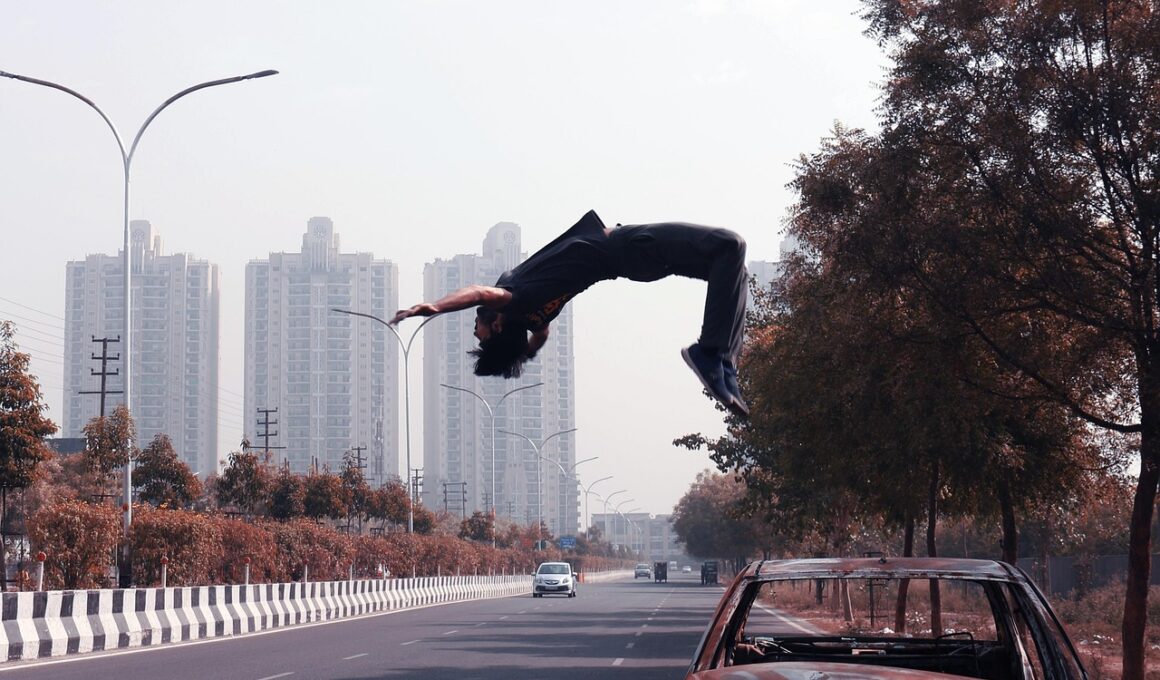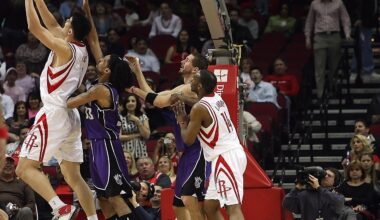Youth and Parkour: Global Programs Empowering Young Athletes
Parkour and freerunning have rapidly gained popularity worldwide, establishing communities that foster growth and creativity among young athletes. These vibrant communities not only provide training opportunities but also encourage mentorship and support. Global parkour programs aim to create safe spaces for youth to express themselves physically while learning essential life skills. Youth engagement in these dynamic activities fosters teamwork, resilience, and discipline. Local initiatives often collaborate with educational institutions to incorporate parkour principles into physical education curricula, promoting healthy lifestyles. Additionally, parkour emphasizes self-improvement, motivating young participants to set and achieve personal goals. With a focus on inclusivity, many parkour clubs welcome diverse backgrounds, breaking down barriers. For young people, parkour challenges them to push their limits while cultivating their individual styles. As these communities flourish across continents, passionate practitioners and coaches emerge to inspire the next generation. The impact of parkour on youth goes beyond mere athleticism; it instills confidence and fosters friendships. Global studies highlight how such programs contribute to positive mental health outcomes, helping youth navigate life’s complexities more effectively. Community events further strengthen connections among participants, showcasing the incredible skills developed through dedication.
Benefits of Structured Parkour Programs
Structured parkour programs specifically designed for youth provide numerous benefits, helping young athletes develop physically and mentally. These programs often emphasize safety, teaching foundational skills before introducing advanced techniques and tricks, thus reducing injury risks. Participants gain physical strength, flexibility, and improved coordination through intensive practice and tailored instruction. As youth engage in these activities, they learn the value of perseverance and adaptability, essential traits that extend to other areas of life. Encouraged by skilled instructors, young athletes discover their potential while developing critical thinking and problem-solving skills. The program’s structure also fosters discipline, as frequent training regimens require commitment and focus. Moreover, parkour challenges traditional notions of fitness, engaging young minds creatively in dynamic movement. This form of exercise promotes a sense of achievement, empowering participants to overcome personal barriers both physically and mentally. Many structured programs also emphasize communal responsibility, requiring participants to support and uplift one another, thus fostering teamwork and camaraderie. Importantly, these environments create a sense of belonging, vital for youth development. Through participation in global parkour communities, young athletes can forge lasting relationships with their peers, ultimately enhancing their social development.
One significant aspect of global parkour communities is their focus on fostering inclusiveness. Many organizations work diligently to welcome participants of all skill levels, ensuring no one feels excluded from enjoying this unique sport. Such inclusive environments have been vital in encouraging youth from diverse backgrounds to participate, providing opportunities for social integration and mutual respect. Programs specifically designed for underprivileged youth seek to create equal access to demanding yet rewarding activities, emphasizing personal growth over competition. By breaking down barriers of socioeconomic status, race, and ability, parkour communities promote equality. Notably, female participation in parkour has been rising due to these supportive networks and visibility provided by role models. Many global initiatives showcase female athletes, providing young girls much-needed inspiration. With ongoing efforts to promote safe spaces for women in parkour, the sport is gradually shedding its stereotypical male-oriented perception. As these inclusive programs thrive, they encourage collaboration, creativity, and connection among youth. Every participant brings unique perspectives, enriching the collective experience within the community. As friendships deep within this supportive environment, young athletes develop their ability to interact positively, forging connections that last well beyond the training grounds.
Global Events and Competitions
Global parkour events and competitions play a significant role in showcasing talent while fostering a sense of community among young athletes. These occasions allow participants to demonstrate their skills and creativity in front of friends, family, and spectators. Organized wisely, these events also promote sportsmanship, teaching valuable lessons in competition, winning with humility, and embracing defeat gracefully. Global competitions often feature diverse participants, highlighting the sport’s growth and geographic reach. Athletes from various countries come together, forming networks that transcend borders while sharing techniques and traditions. Street competitions and showcases often reflect local culture while incorporating unique styles from various regions. This exchange of knowledge contributes positively to the global parkour community’s evolution. Young athletes gain invaluable experience from these events, increasing their exposure to different styles and philosophies. Not only do they take pride in representing their communities, but they also find motivation to continue developing their skills. The friendships created during competitions encourage collaboration beyond borders. Participating in events cultivates ambition and eagerness for growth, prompting youth to strive for excellence, which ultimately elevates the overall performance standards in the parkour community.
Coaching and mentorship play a crucial role in the development of young athletes within the global parkour community. Experienced coaches help guide participants in navigating the challenges presented by this dynamic sport. By providing individualized attention and feedback, mentors contribute to fostering a positive learning environment where youth can thrive. This relationship is significant for athletes, helping them understand movement patterns while honing their skills. Coaches emphasize the importance of mental resilience, guiding young athletes through difficult moments they may encounter during their practice. As mentors instill confidence and discipline, participants develop a stronger sense of identity and purpose within their sport. Many mentoring programs encourage coaches to connect with their mentees on a personal level. This approach creates a supportive foundation for open communication, allowing students to voice their concerns or share triumphs. The bonds formed through mentorship are invaluable, creating lasting friendships beyond the training environment. Moreover, coaching in parkour is often dynamic, with instructors adapting their methods to cater to individual learning styles. These tailored coaching techniques yield better results, enhancing each athlete’s growth journey. The supportive presence of a dedicated mentor can significantly elevate the athletic experience for young participants.
Challenges Faced by Young Athletes
Despite the numerous benefits associated with parkour, young athletes often face challenges throughout their journey. Physical limitations can hinder progression, especially for youth starting later or those lacking access to necessary resources. Additionally, inadequate facilities or training environments may deter some potential participants from embracing the sport. An essential aspect of overcoming these challenges involves education about injury prevention and safe practices. While parkour is thrilling, injury risks exist, and young athletes must learn to protect themselves as they push boundaries. Furthermore, external societal pressures may create additional obstacles. Young athletes often experience challenges balancing academics, family commitments, and the demands of training. This juggling act can be overwhelming, leading some to reconsider their dedication to the sport. Despite these struggles, global parkour communities continue to adapt, offering support through forums and workshops that raise awareness of both mental and physical wellness. These adaptive efforts ensure participants receive encouragement necessary to navigate uncertain times. Share experiences with peers, resiliency becomes a shared theme, uniting young athletes. Such support systems help foster a positive mindset, ultimately benefiting their performance as they face the various challenges, both inherent and external.
Looking ahead, the future of parkour and freerunning for young athletes appears promising, driven by growing global communities committed to empowering youth. As these communities expand, so too does a united dedication to advocacy and education within the parkour realm. Continued emphasis on inclusivity guarantees that future generations have access to safe and supportive spaces to express their creativity. The evolution of parkour techniques will undoubtedly attract more participants, fueling innovations that promise to broaden skill sets and redefine boundaries. Coaches will continue refining their approaches, enhancing participants’ learning experiences through varied training methods. Larger sponsorships and partnerships are likely to develop as the sport’s visibility increases, enabling global programs to expand and reach those in need. Various organizations are already working to secure funding for initiatives aimed at improving accessibility, with a specialized focus on underrepresented communities. As the community strengthens, it will support the release of platforms for connecting enthusiasts around the world. This global reach is vital for knowledge-sharing and will empower youth through continued collaboration, friendships, and unyielding passion for parkour. Ultimately, these unified efforts may shape parkour’s legacy in youth culture, fostering strong connections and personal growth for generations.


